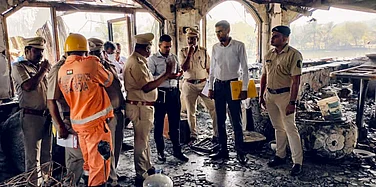Kashmir remains under constant flood threat since the 2014 floods that drowned major parts of the Kashmir Valley, including the capital city of Srinagar. In April this year, as the region received incessant rainfall for a few days, panic spread in the Valley forcing the authorities to come out and say there was no alarming flood-like situation.
However, the latest report named ‘Kashmir Floods 2014—Recovery to Resilience,’ released by the National Institute of Disaster Management (NIDM), Ministry of Home Affairs, has called for corrective measures to prevent disasters like the 2014 floods. The report says unplanned development all across Kashmir could have serious consequences.
The September 2014 floods in Jammu and Kashmir resulted in the death of 300 people. Around two million families were impacted—1.4 million people lost their household assets and livelihoods, 67,000 houses were fully damaged and over 66,000 were partially damaged.
The floods severely affected the healthcare system, with 102 institutions of the Directorate of Health Services in Kashmir being impacted. Four out of the five major hospitals in Srinagar had to be shut down due to the floods. The Government Medical College Srinagar remained submerged in floodwaters for nearly three weeks. Shri Maharaja Hari Singh Hospital, one of the largest premier hospitals in Jammu and Kashmir, was non-functional for over two weeks as the floodwater rendered hospital beds, medical and diagnostic equipment, and hospital transport useless.
The education sector suffered badly as out of 11,526 primary and middle-school buildings, 1,986 collapsed, and 2,685 were partially damaged. Even after the floods, the schools remained affected for up to three months. The housing sector of the Valley alone suffered losses of over Rs 30,000 crore.
Now the new report says there is a need for the installation of flood forecasting and early warning systems at appropriate locations, along with regular monitoring. There are three hydrological stations in Jammu and Kashmir—Sangam, Ram Munshi Bagh and Safpora—installed on the Jhelum River, which runs through the Valley, by the Irrigation and Flood Control Department. In September 2014, these stations detected a rise in water levels from 5.3 meters on September 3, 2014, to 10.13 meters on September 4, 2014.
At that time, the local authorities could not interpret the alarming signals of the rising water levels as these stations were only used to monitor the flow of water from India to Pakistan and were not designated as flood forecasting stations. “If these stations had provided flood forecasts to the state authorities, they could have prepared for flood recovery by initiating early evacuation from low-lying areas, deploying special teams, and arranging relief supplies,” the report says.
The question is whether any improvements have been made in the past eleven years. While failures in the flood forecasting systems and the inadequacy of the existing early warning system likely contributed to the severity of the 2014 floods, the early operation of a flood early warning system for Jhelum and Chenab could have been beneficial. The NIDM says that the flood early warning system requires further improvement.
According to the NIDM, although the erstwhile state government approved a disaster management policy in 2012, the institutional system and allocation of responsibilities to departments during natural disasters are still incomplete. The report notes that the District Disaster Management Authority (DDMA) was not established in most districts of the Union Territory (UT). Gaps and deficiencies were identified in institutional arrangements, policies, and plan formulation, as well as in the implementation of pre-disaster measures.
The NIDM says there is a need for improvement in the utilisation of State Disaster Response Fund (SDRF) funds to augment available resources and ensure their utilisation for intended disaster preparedness and relief. It highlights deficiencies and delays in damage and needs assessment, diversion of relief funds, and delays in reaching relief and assistance to affected individuals. It says there is an urgent need to institutionalise disaster management in the region to address the persisting issues comprehensively.
The report says as per the erstwhile state policy, the existing Centre for Disaster Management at Jammu and Kashmir Institute of Public Administration and Rural Development (J&K IMPARD) was supposed to be upgraded to the state Institute of Disaster Management (SIDM). However, this upgrade has not been accomplished to date. The SIDM aims to fulfill the capacity-building needs in the domain of Disaster Risk Reduction (DRR). It functions as a technical, training, planning, and analysis wing of the State Disaster Management Authority, incorporating the roles of various stakeholders involved in DRR in Jammu and Kashmir, all of which are essential for building resilience in the region.
The report talks at length about haphazard developmental activities, including economic and infrastructure projects, taking place without sufficient consideration for environmental safety and sustainability. These activities include mining operations on the floodplains of the Jhelum River, construction of railway lines, and poorly-planned urbanisation. Most of these developmental activities are carried out with little regard for the environmental, geological, geomorphological, and ecological conditions of the region. The ongoing construction boom, fuelled by indiscriminate mining of sand, gravel, and boulders from riverbeds, weakens the existing flood control infrastructure, making the rivers more susceptible to flash floods, the NIDM says.
The rapid urbanisation in the Valley, encroachment of water bodies in land adjoining river banks, and the disappearance of wetlands have disrupted the natural drainage patterns, according to the report.
While the existing flood control infrastructure in Kashmir was overwhelmed during the 2014 floods, leading to a hazardous situation in the region, the report calls for long-term measures. These measures include the construction of an alternate flood channel from Dogripora to Wullar, improvement of the drainage system in urban areas in the Jhelum basin, restoration of natural drainage, conservation and restoration of degraded wetlands in the Jhelum basin, sewage treatment, and city and town planning that considers flood and earthquake vulnerability, among other structural and non-structural measures.


























